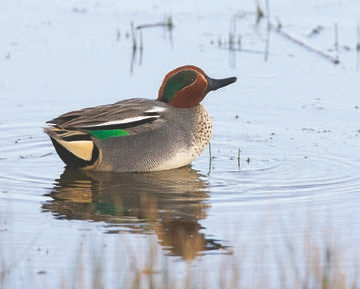
Teal © Richard Steel
This is one of the most frustrating species for fieldworkers in a breeding bird survey. ‘Secretive in habit, breeding Teal have probably always been under-recorded’ (Brown & Grice 2005). They nest in dense cover next to water, from mid-April to June, and usually keep their chicks hidden from view. In this Atlas, breeding season presence was recorded in 96 tetrads; in 36 of them there was ‘possible breeding’ (H); 58 had ‘probable breeding’ through the presence of pairs in 55 tetrads, with display in a further three; but in only two tetrads, at Risley Moss (SJ69Q and SJ69R), was breeding confirmed.
This picture has not changed much since our First Atlas. The map shows that the Mersey valley remains a favoured area, as is the south-west of Cheshire, south of Chester, although observers there find no definitive evidence of breeding. Because of the sporadic records of single birds, the change map uses only the ‘confirmed’ and ‘probable’ breeding records. The annual county bird reports record confirmed breeding in twelve of the nineteen years 1985-2003, six years at just a single site, in five years at two sites and in 2002 Teal bred at three sites. Risley Moss is undoubtedly the key site, with breeding proven by 1-6 pairs in every year from 1998 on. Other sites listed with confirmed breeding in the last decade are Blakemere (SJ57K), Hale Duck Decoy (SJ48R), Acre Nook SQ East (SJ87G) and Haydn Pool (SJ67M), once each, and twice at Woolston.
Elsewhere in Britain – but not in Cheshire – Teal favour oligotrophic waters such as moorland pools, which is presumably why the nutrient-poor lowland bog at Risley Moss is to their liking, but the submitted codes cover a wide range of habitats. Four were in waterlogged woodland, ten in damp grassland and the majority on standing waters of all sizes: 14 on ponds, 32 on small water-bodies, 20 on lakes or reservoirs and 8 on sand quarries. Twelve records came from flowing water, ditches, streams and rivers, but none from canals.
Sponsored by Chester and District Ornithological Society

